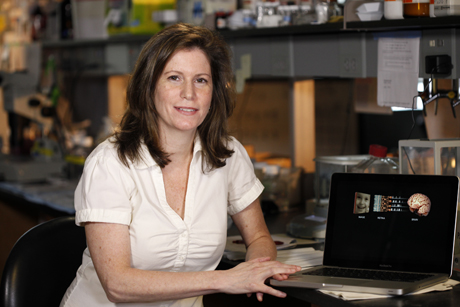Fennie, Nirenberg named MacArthur Fellows
By Anne Ju

Craig Fennie, assistant professor of applied and engineering physics, and Sheila Nirenberg, associate professor of physiology and biophysics at Weill Cornell Medical College, are among this year’s 24 MacArthur Fellows, announced Sept. 25 by the John D. and Catherine T. MacArthur Foundation. Colloquially known as a “Genius Award,” the honor comes with a five-year, $625,000 no-strings-attached stipend.
The fellowships are given to individuals in a variety of fields who have shown “extraordinary originality and dedication in their creative pursuits, and a marked capacity for self-direction,” according to the foundation. They are nominated anonymously by leaders in their respective fields.
In choosing its fellows, the MacArthur Foundation places emphasis on individual creativity, “because the discoveries, actions and ideas that shape our society often result from the path-breaking efforts of individuals.”
Fennie joined Cornell’s applied and engineering physics faculty in 2008 and works in computational and theoretical materials physics. Broadly, he and his research group use theory to study new, structurally and chemically complex solids and nanostructures; for example, transition metal oxides, in which understanding their atomic-level structural complexity is key to explaining their macroscopic properties. They often study systems under extreme conditions, like materials at high pressure or thin films under strain.
Employing a “materials by design” strategy that involves combining microscopic models with principles of chemistry and symmetry, Fennie discovers new materials with predicted physical properties from first principles using techniques like density functional theory, then works closely with experimental physicists to synthesize and test them. Since coming to Cornell, he has correctly predicted ferroelectric and ferromagnetic characteristics of several previously unexplored transition metal oxides.
Said Lance Collins, dean of the College of Engineering: “I am delighted to hear that Craig’s brilliant work at the intersection of physics and materials has been recognized by the MacArthur Foundation. His pioneering use of theory to design new materials that have never been created in the laboratory dramatically reduces the time to optimize materials for specific applications.”
A long-term goal, Fennie says, is to develop a so-called first principles strategy toward materials by design, in part by crossing the border between the traditional disciplines of condensed matter physics and solid-state chemistry.
“It is my strong belief that it would be quite difficult to make a meaningful and long-lasting impact without engaging both disciplines with the same drive and focus,” Fennie said.
Also a researcher at the Energy Materials Center at Cornell, Fennie looks at designing compounds with optical properties that could improve, for example, the efficiency by which materials capture solar energy.
Fennie received his Ph.D. (2006) and M.S. (2003) in physics from Rutgers -The State University of New Jersey, and a B.E.E. (1993) and M.S.E.E. (1996) from Villanova University. From 2006-08 he was the Nicholas Metropolis Fellow at the Center for Nanoscale Materials at Argonne National Laboratory.
He has received numerous other awards including: a Young Investigator Award from the Army Research Office, a Faculty Early Career Award from the National Science Foundation and a Presidential Early Career Award for Scientists and Engineers.

Nirenberg is a neuroscientist at Weill Cornell, exploring fundamental questions about how the brain encodes visual information. She is developing an alternative approach to restoring sight after photoreceptor cell degeneration, according to the MacArthur Foundation website. In the case of diseases such as macular degeneration and retinitis pigmentosa, affecting millions worldwide, vision is lost when deteriorating photoreceptor cells no longer take in signals.
Instead of trying to replace the lost photoreceptor cells, Nirenberg has developed a method for bypassing the damaged cells entirely and interacting directly with ganglion cells. She has crystallized the complex relationship between visual stimuli and corresponding ganglion cell activity and deciphered the specific neural “codes” that are generated in response to dynamic spatial and temporal visual patterns. She has invented a computerized eyeglass prosthetic that transmits the codes to the ganglion cells, which then send the codes to the brain.
In another line of research, Nirenberg is adapting and applying her discoveries in neural coding to machine vision algorithms with the goal of advancing the state of the art in robotic “vision” and brain-machine interfaces. In addressing fundamental questions about sensory signal processing in both mammals and machines, Nirenberg is poised to catalyze a major leap in the science of visual perception.
Nirenberg received a B.A. from the State University of New York, Albany, and a Ph.D. from Harvard University (1993). She is also a member of the Institute for Computational Biomedicine at Weill Cornell.
For more information: http://www.macfound.org/
Media Contact
Get Cornell news delivered right to your inbox.
Subscribe